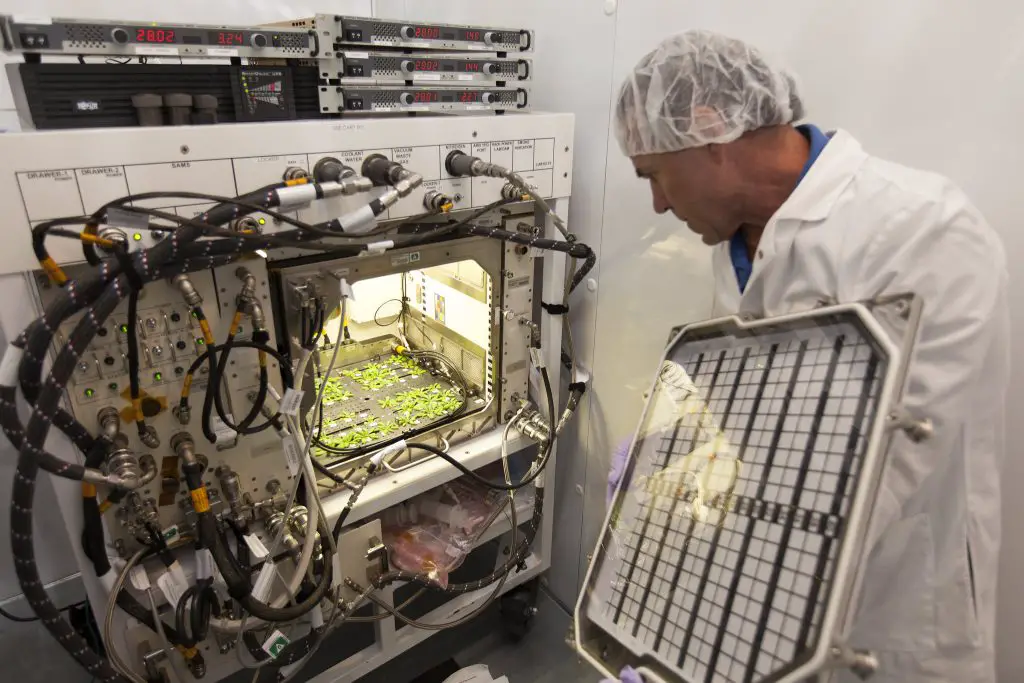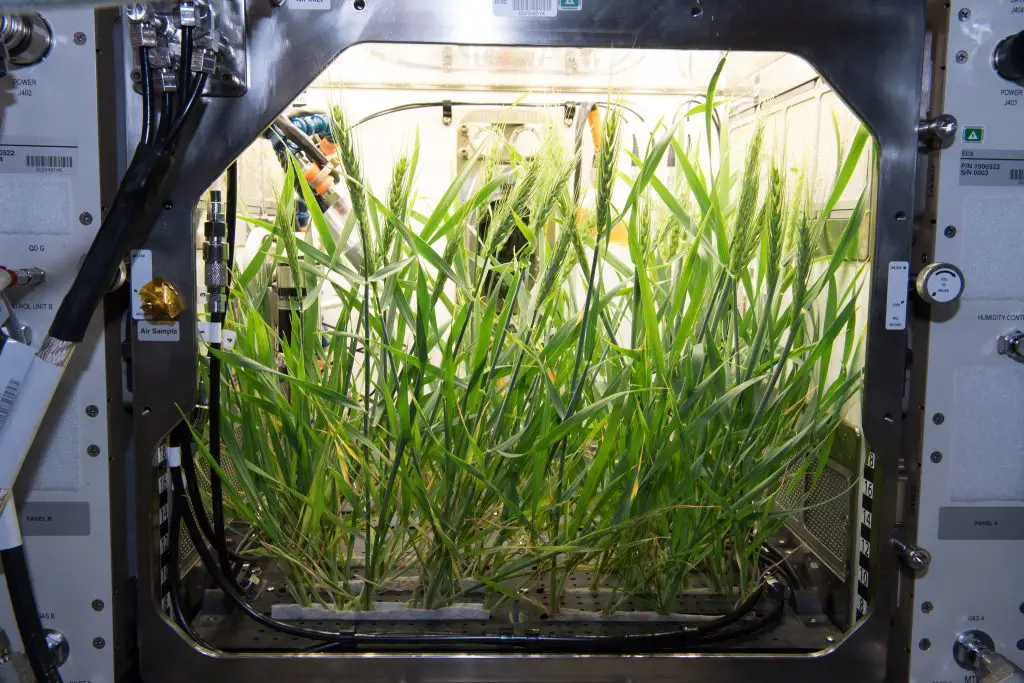Plants do not grow faster in space compared to on earth. Plants grown in space experience slower growth rates and face several challenges due to the absence of gravity, such as limited access to essential resources like water and sunlight.
Consequently, space-grown plants tend to be smaller, with reduced yields and altered characteristics. Despite attempts to optimize cultivation conditions and develop advanced technologies like hydroponics, astronauts currently rely on supplemental food supplies from earth during their space missions. Studying plant growth in space is crucial for long-duration space exploration and colonization plans, as it helps scientists understand how to sustain astronauts with fresh produce in the challenging extraterrestrial environments they may encounter.

Credit: en.wikipedia.org
The Impact Of Space Environment On Germination And Growth
Plants have always been associated with the earth’s surface, where gravity and other environmental factors shape their growth and development. However, when it comes to exploring the potential of plants in space, scientists have been intrigued by the impact of the space environment on germination and growth.
In this section, we will delve into the effects of microgravity on seed germination, root development, and shoot elongation.
How Microgravity Affects Seed Germination:
- Germination is the process by which a seed develops into a plant. In a microgravity environment, seeds face unique challenges and opportunities. Here’s what happens:
- Seeds in space undergo altered moisture conditions, which can influence the rate and success of germination.
- The lack of gravity affects how water is distributed within the seed, potentially impacting enzyme activation and overall metabolic processes.
- Microgravity eliminates the natural gravitropic response, changing the orientation of the emerging root and shoot.
Investigating The Influence Of Reduced Gravity On Root Development:
- Roots play a crucial role in a plant’s absorption of nutrients and water. Under the effects of reduced gravity in space, root development undergoes notable changes:
- In microgravity, roots exhibit random growth patterns and a reduced ability to explore the soil. This can affect nutrient uptake and overall plant health.
- The absence of gravity decreases the mechanical cues that roots rely on to navigate their growth. This results in altered root architecture and branching patterns.
The Role Of Microgravity In Promoting Shoot Elongation:
- Shoot elongation refers to the vertical growth of a plant’s stems and leaves. In a microgravity environment, certain factors contribute to enhanced shoot growth:
- Reduced gravity results in the absence of the geotropism response, causing the shoot to grow straight and upward, uninhibited by the need to counteract gravity.
- The lack of gravitational stress allows plants to allocate more energy towards shoot development, leading to taller and more slender plants overall.
- Microgravity encourages the proliferation of cytokinins, growth-promoting hormones, resulting in accelerated shoot elongation.
Understanding the impact of the space environment on plant germination and growth is crucial for future missions and potential colonization efforts. By exploring these factors, scientists can devise strategies to optimize plant growth in space habitats, ensuring sustainability and providing valuable resources for astronauts.
Nutrient Availability In Space And Its Effect On Plant Growth
Do Plants Grow Faster In Space
Exploring The Challenges Of Nutrient Delivery In A Microgravity Environment
In order to understand the growth of plants in space, it is important to consider the challenges of nutrient delivery in a microgravity environment. Space conditions present unique obstacles that can impact the availability of essential nutrients for plants. Here are the key points to consider:
- Limited nutrient distribution: In space, the absence of gravity makes it challenging for nutrients to evenly distribute throughout the plant root system. This can lead to uneven nutrient uptake, which may affect the overall growth of the plant.
- Reduced water uptake: Water is crucial for nutrient absorption in plants. In a microgravity environment, water uptake is restricted due to the absence of gravity-driven processes such as capillary action. This limitation can hinder the plant’s ability to acquire nutrients efficiently.
- Lack of convection: Convection, the process of heat transfer through fluid circulation, plays a significant role in nutrient uptake in traditional earth-based conditions. However, in space, convection is minimized, which can impede the movement of nutrients towards the roots of plants.
Evaluating The Impact Of Nutrient Availability On Plant Growth In Space
The availability of nutrients in space has a profound impact on the growth of plants. Here are the key points to consider:
- Nutrient deficiencies: Limited nutrient availability in space can lead to nutrient deficiencies, which may manifest as stunted growth, yellowing of leaves, or reduced overall plant health. Identifying and addressing these deficiencies is crucial to maximize plant growth in space.
- Impaired photosynthesis: Nutrient availability directly impacts the photosynthetic process in plants. In space, nutrient deficiencies can hamper photosynthesis, a vital process for plant growth, resulting in reduced biomass production and slower growth rates.
- Altered mineral nutrient ratios: In space, the absence of gravity can disrupt the normal uptake and distribution of mineral nutrients in plants. This can lead to imbalances in nutrient ratios, affecting various metabolic processes and potentially compromising plant growth.
Potential Strategies To Optimize Nutrient Uptake In Plants Grown In Space
Efforts are being made to overcome the challenges of nutrient delivery in a microgravity environment and optimize plant growth in space. Here are potential strategies to improve nutrient uptake:
- Root zone optimization: Researchers are exploring ways to create optimal root zone conditions in space, such as using porous growth substrates or hydroponic systems, to enhance nutrient absorption and distribution.
- Nutrient enhancement: Scientists are working on developing nutrient formulations specifically tailored for space conditions. These formulations aim to provide plants with a balanced and readily available supply of nutrients, compensating for the limitations imposed by the microgravity environment.
- Biological symbiosis: Exploring plant-microbe interactions in space may offer potential solutions to nutrient uptake challenges. Certain microorganisms can enhance nutrient availability to plants by facilitating nutrient absorption or fixing atmospheric nitrogen.
Nutrient availability plays a crucial role in the growth of plants in space. Overcoming the challenges of nutrient delivery in a microgravity environment is crucial for successful plant cultivation and sustainable space habitation.
Light And Photosynthesis In A Zero-Gravity Environment
Plants have been a source of fascination for scientists exploring the vast potential of space exploration. One intriguing question that holds the attention of researchers is whether plants grow faster in space. By understanding the importance of light and photosynthesis in a zero-gravity environment, we can uncover the secrets behind plant growth in outer space.
Understanding The Importance Of Light For Plant Growth And Development
- Light serves as the primary source of energy for photosynthesis, enabling plants to convert carbon dioxide into oxygen and glucose.
- Plants rely on different wavelengths of light for various stages of growth, from seed germination to flower blooming.
- Light intensity and duration play a crucial role in determining the rate of photosynthesis and overall plant development.
Investigating The Effects Of Microgravity On Photosynthesis
- In a zero-gravity environment, plant growth is influenced by the absence of gravity. This altered gravitational force affects the distribution of water and nutrients in the plant system.
- Studies conducted on the international space station (iss) have shown that plants in space exhibit differences in leaf orientation and root growth patterns compared to their counterparts on earth.
- The effects of microgravity on photosynthesis are still being researched, with ongoing experiments aiming to unravel the impact of this unique environment on plant biology.
Strategies To Optimize Light Exposure For Plants In Space
- To maximize plant growth in space, scientists have developed various strategies to optimize light exposure, including the use of led lights with specific wavelengths tailored to different plant species.
- Placement of reflective materials around plants can help redirect light and ensure even distribution to all sides of the plant.
- Continuous monitoring and adjustment of light intensity and duration are essential to provide the ideal environment for photosynthesis in space.
Understanding the role of light and photosynthesis in a zero-gravity environment is essential to unraveling the mysteries of plant growth in space. By investigating the effects of microgravity on photosynthesis and employing strategies to optimize light exposure, scientists are inching closer to unlocking the potential of cultivating plants beyond the confines of earth.
Frequently Asked Questions For Do Plants Grow Faster In Space
Can Plants Grow Faster In Space Without Gravity?
Plants in space grow differently due to the absence of gravity. Without gravity, plants exhibit altered growth patterns, resulting in longer stems and faster growth rates. They rely on other cues like light and air movement to guide their growth.
Do Plants Grow Faster In Space Than On Earth?
Plants in space often grow faster than their counterparts on earth. The absence of gravity in space alters their growth patterns and allows for faster growth. Additionally, the controlled environment and constant access to nutrients and water contribute to their accelerated growth.
How Do Plants Grow In Space Without Soil?
Plants in space do not rely on soil for growth. Instead, they are cultivated using hydroponic systems, where the plants’ roots are immersed in a nutrient-rich water solution. This allows the plants to receive essential elements for growth without the need for traditional soil.
What Role Does Light Play In Plant Growth In Space?
Light is crucial for plant growth in space as it serves as the primary source of energy for photosynthesis. Specialized growth chambers in space missions provide plants with the necessary light spectrum to facilitate photosynthesis and promote healthy growth.
Can Space-Grown Plants Be Consumed By Astronauts?
Yes, space-grown plants can be consumed by astronauts onboard the spacecraft. These plants serve as a food source, providing astronauts with fresh produce, nutrients, and psychological benefits associated with growing their own food. They contribute to a varied and balanced diet during space missions.
Conclusion
To sum up, the fascinating research on plant growth in space has provided valuable insights into the effects of microgravity on plants. Astronauts’ experiments have demonstrated that plants do indeed grow faster in space due to the absence of gravity, which affects how plants take up water and nutrients.
These findings have significant implications for space exploration and future colonization efforts, as it may be possible to grow fresh food in space to sustain astronauts on long-duration missions. Moreover, studying plant growth in space can also benefit agriculture on earth by offering new solutions to enhance crop productivity and adaptability.
As we continue to push the boundaries of space exploration, further research in this field will undoubtedly contribute to our understanding of plant biology and offer innovative solutions for both space and earth. The growth and development of plants in the unique environment of space hold promise for a greener future for humanity, both on our planet and beyond.


